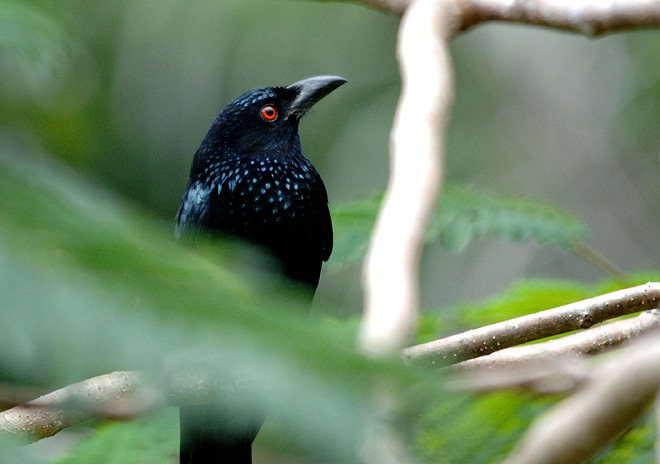There’s not many names that suit the character of a creature as aptly as the Spangled Drongo, a sort of yobo of the avian world that’s earned its name through its often comical and clamorous behaviour.
The sound this bird makes has been likened to that of a stifled sneeze, followed by a strangled cat-like noise, which is then followed by something that resembles strings being inharmoniously plucked and stretched in an overexerted frenzy.

Not all birds, it seems, are meant to bring delight to the ears. Maybe it’s the job of the Spangled Drongo to bring a bit of variety and comic relief into the world.
In any case, the spangled part of this bird’s name comes from the blue highlights that adorn its black coat. Spangled, being to sparkle or twinkle. It also has a long and forked tail, which gives the appearance of two distinct feathers being crossed over each other.
A born entertainer, the Spangled Drongo is known to chase raw meat that’s been tossed into mid-air, accurately catching it with a spectacular swoop. It also eats insects and small birds, nabbing them in similar fashion. Long wire bristles bordering the bird’s beak help guide prey into its mouth.
Also an excellent mimic, the Spangled Drongo picks up sounds it hears and weaves them into its twisted, cacophonous cackle. Interestingly, it’s also often silent, making its behaviour seem even more erratic when in full swing.
Typically aggressive towards other species, the Spangled Drongo can be found throughout northern and eastern Australia, as well as New Guinea and eastern Indonesia. They prefer wet forests, but also subsist in woodlands, parks or amongst mangroves. True to its capricious nature, it’s also known to occasionally turn up in Tasmania.
In breeding, both sexes take part in building the nest, which is a motley construction of twigs, vines and grass held together with spider webs. This is placed in a horizontal fork of a tree, typically 10 – 20 metres above ground, which the Spangled Drongo will spiritedly defend.
